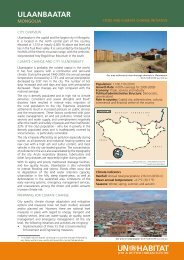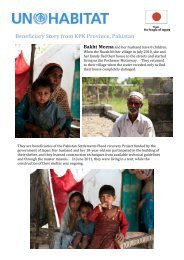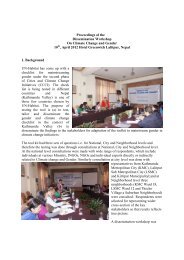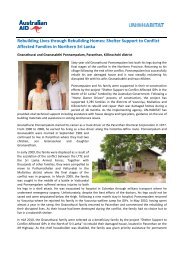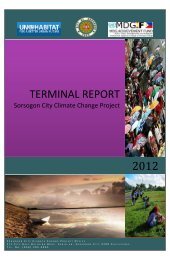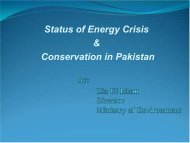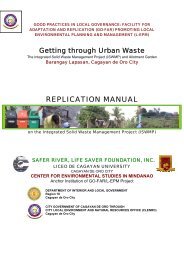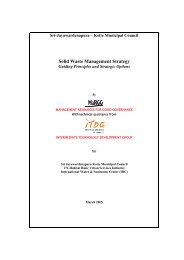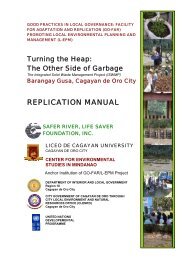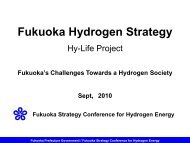Climate resilient action plans for Coastal urban areas in Sri Lanka ...
Climate resilient action plans for Coastal urban areas in Sri Lanka ...
Climate resilient action plans for Coastal urban areas in Sri Lanka ...
You also want an ePaper? Increase the reach of your titles
YUMPU automatically turns print PDFs into web optimized ePapers that Google loves.
LessonsLearntAcknowledgementThis report has been prepared by the project team of the <strong>Climate</strong> <strong>resilient</strong> <strong>action</strong><strong>plans</strong> <strong>for</strong> <strong>Coastal</strong> <strong>urban</strong> <strong>areas</strong> <strong>in</strong> <strong>Sri</strong> <strong>Lanka</strong> (CCSL).We acknowledge the Nordic <strong>Climate</strong> Facility (NCF) <strong>for</strong> fund<strong>in</strong>g the project. Nordic<strong>Climate</strong> Facility (NCF) is f<strong>in</strong>anced by the Nordic Development Fund (NDF) andimplemented jo<strong>in</strong>tly with the Nordic Environment F<strong>in</strong>ance Corporation (NEFCO).His worship<strong>in</strong>g deputy mayors, commissioners of Batticaloa Municipal Council andNegombo Municipal Council, staff of both municipalities are greatly acknowledged<strong>for</strong> their support extended to successful implementation of the project activities.Lessons Learnt Tra<strong>in</strong><strong>in</strong>g Manual<strong>for</strong> <strong>Sri</strong> <strong>Lanka</strong>n <strong>Coastal</strong>2
LessonsLearntContentsEXECUTIVE SUMMARY................................................................................ 1ACKNOWLEDGEMENT................................................................................. 2PROJECT TEAM ......................................................................................... 4ABBREVIATIONS ....................................................................................... 6INTRODUCTION ........................................................................................ 71. ACTIVITY 1.2:Water resource management, and especially dra<strong>in</strong>age and sanitation impactsfrom more <strong>in</strong>tense ra<strong>in</strong>fall events, supported by a Pre-Feasibility Study (PFS) <strong>for</strong>fund<strong>in</strong>g support from the SIDA supported City Development Initiative <strong>for</strong> Asia(CDIA)..................................................................................................... 82. ACTIVITY 1.3:Multi-purpose green belt (12 km <strong>in</strong> length of BMC coast) established to protectthe lagoon and coastal <strong>areas</strong>, restore mangrove eco-systems & coastal biodiversity................................................................................................ 133. ACTIVITY 1.4:GIS-based Rapid Response System (RRS)& Knowledge Management centre <strong>for</strong>climate exacerbated disasters established at BMC & NMC with tra<strong>in</strong><strong>in</strong>g (1 month<strong>for</strong> selected 50 participants) and equipments (build<strong>in</strong>g, Software, 20 computers,10 GPS, pr<strong>in</strong>ters, scanners, broadband facilities) ......................................... 204. ACTIVITY 1.5:Disaster <strong>resilient</strong>; energy efficient; low-cost shelter adaptation tra<strong>in</strong><strong>in</strong>g,supported by local resource based- livelihood diversifications options <strong>for</strong> 100participants live <strong>in</strong> vulnerable <strong>areas</strong> ........................................................... 26Lessons Learnt Tra<strong>in</strong><strong>in</strong>g Manual<strong>for</strong> <strong>Sri</strong> <strong>Lanka</strong>n <strong>Coastal</strong>3
LessonsLearntProject teamUniversity of Moratuwa (UoM), Faculty of Architecture, <strong>Sri</strong> <strong>Lanka</strong>Prof. P.K.S.MahanamaMr. Thilak HewawasamMr. Amila B. Jayas<strong>in</strong>gheMs. C. Chethika AbenayakeDean, Faculty of ArchitectureTeam Leader, UoMConsultant (Livelihood Development)Infrastructure Planner & GIS SpecialistEnvironmental PlannerMr. Chathura De Silva Project Secretary and Consultant (UrbanPlann<strong>in</strong>g)Ms. Suharsha Kumaras<strong>in</strong>gheMr. Kirshan Stanis BarthelotMs. Dileka BandaraMs. Laleema SenanayakeProject Associate (Environmental Plann<strong>in</strong>g)Project Associate (Participatory Plann<strong>in</strong>g)Project Assistant (Environmental Plann<strong>in</strong>g)Project Assistant (Environmental Plann<strong>in</strong>g)Norwegian Institute of Water Research (NIVA), NorwayDr. Isabel SiefertMs. Silje HolenMs. L<strong>in</strong>e BarkvedProject Manager (NIVA)Research Scientist (NIVA)Research Scientist (NIVA)Batticoloa Municipal Council (BMC), <strong>Sri</strong> <strong>Lanka</strong>Mr. K. SivanathanCommissioner, Batticaloa Municipal CouncilNegombo Municipal Council (NMC), <strong>Sri</strong> <strong>Lanka</strong>Ms. Mallika FernandoMs.V S VijieCommissioner, Negombo Municipal CouncilTechnical Officer, Negombo Municipal CouncilLessons Learnt Tra<strong>in</strong><strong>in</strong>g Manual4<strong>for</strong> <strong>Sri</strong> <strong>Lanka</strong>n <strong>Coastal</strong>
LessonsLearntUN Habitat, <strong>Sri</strong> <strong>Lanka</strong>Mr. Laxman PeraraNational project Coord<strong>in</strong>ator, SLSupportive TeamMr. Raj KithsiriMs. MadhushiMr. Lasantha BandaraMs. E. Shirom<strong>in</strong>iMs. T. JezanTechnical officer(Faculty of Architecture, UOM)Adm<strong>in</strong>istrative officer(Faculty of Architecture, UOM)GIS, Workshop and Field Survey Assistant(Dept. Of Town & Country Plann<strong>in</strong>g, UOM)GIS, Workshop and Field Survey Assistant(Dept. Of Town & Country Plann<strong>in</strong>g, UOM)GIS, Workshop and Field Survey Assistant(Dept. Of Town & Country Plann<strong>in</strong>g, UOM)Lessons Learnt Tra<strong>in</strong><strong>in</strong>g Manual<strong>for</strong> <strong>Sri</strong> <strong>Lanka</strong>n <strong>Coastal</strong>5
LessonsLearntAbbreviationsIPCCEM DATCREDUNNGOLSSSLDRNGISQGISGNBMCNMCGPSKMC: Intergovernmental panel on climate change: Emergency events database: Center <strong>for</strong> research on environmental decisions: United Nations: Non-Governmental Organizations: Logistics Support Systems: <strong>Sri</strong> <strong>Lanka</strong> Disaster Resource Network: Geographical In<strong>for</strong>mation Systems: Quantum Geographical In<strong>for</strong>mation Systems: Grama Niladari: Batticaloa Municipal Council: Negombo Municipal Council: Global Position<strong>in</strong>g System: Knowledge Management CenterDS Division : Divisional Secretariat DivisionPFMPGISCRSCCSLCRASSAPLIDARDTMSAR: Participatory Flood Mapp<strong>in</strong>g: Participatory Geographical In<strong>for</strong>mation Systems: Coord<strong>in</strong>ate Reference System: <strong>Climate</strong> <strong>resilient</strong> <strong>action</strong> <strong>plans</strong> <strong>for</strong> coastal <strong>urban</strong> <strong>areas</strong> of <strong>Sri</strong> <strong>Lanka</strong>: <strong>Climate</strong> Resilient Adaptation Strategies & Support<strong>in</strong>g Action Plans: Light Detection and Rang<strong>in</strong>g: Digital Terra<strong>in</strong> Model: Synthetic Aperture RadarLessons Learnt Tra<strong>in</strong><strong>in</strong>g Manual<strong>for</strong> <strong>Sri</strong> <strong>Lanka</strong>n <strong>Coastal</strong>6
LessonsLearntIntroductionThe 4 CRASSAPs under the project titled <strong>Climate</strong> Resilient Action Plans <strong>for</strong><strong>Coastal</strong> Urban Areas are; Water resource management, and especially dra<strong>in</strong>ageand sanitation impacts from more <strong>in</strong>tense ra<strong>in</strong>fall events, supported by a Pre-Feasibility Study (PFS) <strong>for</strong> fund<strong>in</strong>g support from the SIDA supported CityDevelopment Initiative <strong>for</strong> Asia (CDIA); A multi-purpose green belt (12 km <strong>in</strong>length) was established to protect the lagoon and coastal <strong>areas</strong>, restoremangrove eco-systems & coastal bio-diversity <strong>in</strong> BMC area; GIS-based RapidResponse Systems (RRS) & two Knowledge Management centers <strong>for</strong> climateexacerbated disasters were established at BMC & NMC with a tra<strong>in</strong><strong>in</strong>g (1 month<strong>for</strong> selected 50 participants) and equipments (build<strong>in</strong>g, Software, 20 computers,10 GPS, pr<strong>in</strong>ters, scanners, broadband facilities); and Disaster <strong>resilient</strong>; energyefficient; low-cost shelter adaptation tra<strong>in</strong><strong>in</strong>g, supported by local resource basedlivelihooddiversifications options <strong>for</strong> 100 participants live <strong>in</strong> vulnerable <strong>areas</strong>.When implement<strong>in</strong>g these activities at ground level, the project team learntvarious lessons. These lessons consist of appreciation factors as well as factors tobe improved. This document consists of these factors <strong>in</strong> a descriptive manner.Lessons Learnt Tra<strong>in</strong><strong>in</strong>g Manual<strong>for</strong> <strong>Sri</strong> <strong>Lanka</strong>n <strong>Coastal</strong>7
LessonsLearntMa<strong>in</strong> Activity:Assess the dra<strong>in</strong>age and sanitation impacts dur<strong>in</strong>g the <strong>in</strong>tensivera<strong>in</strong>fallsSub Activity 01: Dra<strong>in</strong>age network and a waste water treatment plant <strong>in</strong> BMCDescription After analyz<strong>in</strong>g the last 40 years ra<strong>in</strong>fall andtemperature data of BMC area, the impacts frompossible changes of the temperature and ra<strong>in</strong>fall on thedra<strong>in</strong>age and sanitary condition were assessed; The entire activity was divided <strong>in</strong>to 3 ma<strong>in</strong> phases; i.reconnaissance survey (to identify the specific locationsthat the problem severely occurred), ii. Stakeholderconsultation (the responsible persons, <strong>in</strong>stitutions andorganizations which deals with the matter), iii.Household survey (to identify the exact problem at theground level);After analyz<strong>in</strong>g the collected data and <strong>in</strong><strong>for</strong>mation, itwas identified that the most parts of the Batticaloa Townis <strong>in</strong>undated dur<strong>in</strong>g floods because of the poor dra<strong>in</strong>agenetwork which has constructed without consider<strong>in</strong>g therequired capacity and gravity as well as due to the poorma<strong>in</strong>tenance;The next identified issue was that there is no pipedsewerage <strong>in</strong> Batticaloa (except at teach<strong>in</strong>g hospital andprison) which leads to severe problems dur<strong>in</strong>g the ra<strong>in</strong>yseason as sewage contam<strong>in</strong>ation to fresh water sourceswhich is most important as well as rare resource toBatticaloa; andLessons Learnt Tra<strong>in</strong><strong>in</strong>g Manual<strong>for</strong> <strong>Sri</strong> <strong>Lanka</strong>n <strong>Coastal</strong>9
LessonsLearntAfter identify<strong>in</strong>g above two as ma<strong>in</strong> issues, the teamdecided to <strong>in</strong>troduce a detailed design <strong>for</strong> the dra<strong>in</strong>agenetwork and <strong>for</strong> a waste water treatment plant <strong>in</strong> BMC.Lessons learntAppreciation factorsDesign<strong>in</strong>g a proper dra<strong>in</strong>age network and a waste watertreatment plant was identified as an option <strong>for</strong> exist<strong>in</strong>gdra<strong>in</strong>age and sanitation impacts at the <strong>in</strong>tensivera<strong>in</strong>falls;Be<strong>for</strong>e we are go<strong>in</strong>g to start a detail <strong>in</strong>vestigation, aproper case study area should be selected that canexperience the acute problem;When select<strong>in</strong>g a case study area the availableresources to per<strong>for</strong>m the <strong>action</strong> should be ensured, suchas time allocation, labour requirement and availability,budget allocations;The stakeholder consultation is the most important partof this k<strong>in</strong>d of project s<strong>in</strong>ce these types of activitiesmostly deals with the community and the communityshould be benefitted by these activities. Hence, all thestakeholders who are responsible <strong>for</strong> the activity have tobe identified, coord<strong>in</strong>ated and <strong>in</strong>corporated to theactivity at the all levels (municipal officers, NGOs, otherrespective organizations, general public); andBe<strong>for</strong>e <strong>in</strong>itiat<strong>in</strong>g household survey, the survey team hasto have general idea about the exist<strong>in</strong>g situation at thefield by conduct<strong>in</strong>g a reconnaissance survey. Then, thesurvey team will be able to conduct and collect therelevant <strong>in</strong><strong>for</strong>mation at the field as they have basicunderstand<strong>in</strong>g about the magnitude of the context ofthe issue.Lessons Learnt Tra<strong>in</strong><strong>in</strong>g Manual<strong>for</strong> <strong>Sri</strong> <strong>Lanka</strong>n <strong>Coastal</strong>10
LessonsLearntSub Activity 02: Improved sanitary facilities <strong>for</strong> a low <strong>in</strong>come communityconsider<strong>in</strong>g the effects of climate change <strong>in</strong> NMC.Description In case of the NMC with regard to climate change, thesanitation issues are at considerable level as it is also acoastal town;As a model village to <strong>in</strong>vestigate the actual situation,‘Monako gama’ located with<strong>in</strong> the NMC doma<strong>in</strong> wasselected. All together there were about 88 houseslocated <strong>in</strong> the village and all the toilets are simple squattype toilets which connected to 18 septic tanks. Thelocation of the septic tanks is <strong>in</strong>accessible <strong>for</strong> amunicipal gully-sucker;In ra<strong>in</strong>y seasons these septic tanks overflow and mixwith the Lagoon waters of the Negombo Lagoon andeven flows <strong>in</strong> the dra<strong>in</strong>ages of the area. There<strong>for</strong>e theresidents <strong>in</strong> ‘Monako gama’ have found ways to handleoverflow<strong>in</strong>g septic tanks by their own by construct<strong>in</strong>g<strong>in</strong>dividual tanks. Hence, this situation seemed as apotential risk <strong>for</strong> health problems as well as thepollution of the lagoon, caused by the contam<strong>in</strong>ation ofuntreated wastewater; andHence, it was decided to <strong>in</strong>troduce and implement drytoilets with simple pr<strong>in</strong>cipal: Don’t mix! human ur<strong>in</strong>eand faeces; faeces and water. By keep<strong>in</strong>g ur<strong>in</strong>e andfaeces, it can reduce or even elim<strong>in</strong>ate problems of badodder and fly breed<strong>in</strong>g. Then facilitate to storagetreatment and transport.Lessons learnt Be<strong>for</strong>e implement<strong>in</strong>g any project, it should aware thefocus community regard<strong>in</strong>g the project <strong>in</strong>tension andgive a proper and complete idea on what is go<strong>in</strong>g to beLessons Learnt Tra<strong>in</strong><strong>in</strong>g Manual<strong>for</strong> <strong>Sri</strong> <strong>Lanka</strong>n <strong>Coastal</strong>11
LessonsLearntdone under the project. If it is a completely new conceptto the community, then that concept has to beconv<strong>in</strong>ced to the community <strong>in</strong> a strategic manner;In the case of ‘Monaco Gama’, it was identified that thema<strong>in</strong> causes <strong>for</strong> the hesitation <strong>for</strong> accept<strong>in</strong>g the drytoilets, were the less promotion, education and tra<strong>in</strong><strong>in</strong>gof the <strong>in</strong>tended users. Thus, proper <strong>plans</strong> have to beprepared to make familiarize the concept to the peoplebe<strong>for</strong>e the implementation of such concepts;The other factors were that cultural factors, ethics andbeliefs also <strong>in</strong>fluenced the acceptance of the <strong>in</strong>troducedconcept;Personal or cultural response to the fact that humanfaeces are malodorous and potentially dangerous.Mostly this comes with the culture of different societies.Especially <strong>in</strong> the Asian context, it is hard to change thetraditional methods of clean<strong>in</strong>g of human excretawithout mix<strong>in</strong>g water with the excreta; andMostly, addititive materials which want to be use afterus<strong>in</strong>g the toilet as ash, burned paddy husk, lime etc ishard to f<strong>in</strong>d <strong>in</strong> <strong>urban</strong> context. F<strong>in</strong>d<strong>in</strong>g of ash alsobecome difficult s<strong>in</strong>ce majority is us<strong>in</strong>g gas <strong>for</strong> cook<strong>in</strong>gpurpose. Hence, these adititive materials seem to be aproblem to them <strong>in</strong> terms of availability.Lessons Learnt Tra<strong>in</strong><strong>in</strong>g Manual<strong>for</strong> <strong>Sri</strong> <strong>Lanka</strong>n <strong>Coastal</strong>12
LessonsLearnt2. Activity 1.3:Multi-purpose green belt (12 km <strong>in</strong> length of BMC coast)established to protect the lagoon and coastal <strong>areas</strong>, restoremangrove eco-systems & coastal bio-diversityRedesign<strong>in</strong>g of the multipurpose green belt was identified as the activity 1.3 of‘<strong>Climate</strong> <strong>resilient</strong> <strong>action</strong> <strong>plans</strong> <strong>for</strong> <strong>Coastal</strong> <strong>urban</strong> <strong>areas</strong> <strong>in</strong> <strong>Sri</strong> <strong>Lanka</strong>’ (CCSL)project. Redesign<strong>in</strong>g of the multipurpose green belt is the first CRASSAP<strong>for</strong>mulated under the above task which was implemented exclusively on BMC.Presence of green network could significantly contribute <strong>in</strong> reduc<strong>in</strong>g thevulnerability to local communities with the impacts of the natural disastersexacerbated by climate change. The project concept and the need of greennetwork <strong>for</strong> Batticaloa were evolved by the op<strong>in</strong>ions of local stakeholders dur<strong>in</strong>gthe previous project titled ‘City Development Strategies to respond climatechange <strong>in</strong> coastal <strong>urban</strong> <strong>areas</strong> of <strong>Sri</strong> <strong>Lanka</strong>’, undertaken by UN-Habitat, <strong>Sri</strong> <strong>Lanka</strong><strong>in</strong> partnership with University of Morattuwa <strong>in</strong> 2010. Ow<strong>in</strong>g to the importance ofthe coastal <strong>areas</strong>, redesign<strong>in</strong>g the green belt of the 12km coastal belt <strong>in</strong> BMCarea was demad<strong>in</strong>g <strong>action</strong>.After review<strong>in</strong>g the present vegetation pattern <strong>in</strong> the area, the redesign<strong>in</strong>g of themultipurpose green belt <strong>action</strong> plan was <strong>in</strong>itiated its activities adher<strong>in</strong>g to thedesign considerations of resilience to multi-disaster situations, facilitate thecommunity activities through spatial re-arrangements, enhance the Bio diversityof coastal eco-systems, protect the coastal beaches and other geo-morphological<strong>for</strong>ms from sudden w<strong>in</strong>d and wave processes, strengthen the economic benefittransfers to local community.Redesign<strong>in</strong>g of the multipurpose green belt, CRASSAP is based on a series ofrapid assessments <strong>in</strong>clud<strong>in</strong>g Plant <strong>in</strong>ventory of coastal belt, Land cover mapp<strong>in</strong>g,activity survey and a comprehensive local stakeholder consultation process. Thef<strong>in</strong>d<strong>in</strong>gs of basel<strong>in</strong>e studies the coastal belt of the area revealed mismatch <strong>areas</strong>of exist<strong>in</strong>g green belt particularly there were some stretches where the greenLessons Learnt Tra<strong>in</strong><strong>in</strong>g Manual<strong>for</strong> <strong>Sri</strong> <strong>Lanka</strong>n <strong>Coastal</strong>13
LessonsLearntbelt discont<strong>in</strong>ued and some other stretches have disturbed after tsunami (2004)and flood (2010/11).Need of redesign<strong>in</strong>g of the green belt was well recognized by local stakeholders.Five sites along the 12 km stretch were selected to undertake pilot projects. Theproject prepared five <strong>action</strong> <strong>plans</strong> with detailed designs of the green belt <strong>for</strong>Poonachchimunai, Kallady, Thiruchchendur, Dutch Bar and Navallady <strong>areas</strong>.The detailed designs were prepared after consultation with the local communitiesand the designs were verified at a multi-stakeholder validation meet<strong>in</strong>g with thecommon consensus supported by local political will and commitment on way<strong>for</strong>ward. This text comprises with the summarized project process and designsolutions validated at the participatory approach of the project implementation.Lessons Learnt Tra<strong>in</strong><strong>in</strong>g Manual<strong>for</strong> <strong>Sri</strong> <strong>Lanka</strong>n <strong>Coastal</strong>14
LessonsLearntMa<strong>in</strong> Activity:Multi-purpose green belt (12 km) established <strong>in</strong> BMC area to protectthe lagoon and coastal <strong>areas</strong>, restore mangrove eco-systems &coastal bio-diversitySub Activity 01: Formulation of the activity 1.3 based on a technical analysisDescription A technical analysis carried out by the UOM projectteam revealed that changes recorded <strong>in</strong> the climaticconditions <strong>in</strong> the BMC area. Basically the reconnaissancesurveys and the stakeholder mapp<strong>in</strong>g was carried out atthe <strong>in</strong>itial stage. Focus group discussions and thetechniques such as Delphi techniques were adoptedlater.Lessons learntAppreciation factorsMulti-purpose green belt is a defense mechanism toreduce exposure to climate exacerbated disasters asfrequent storm surges and strong w<strong>in</strong>ds, sea level riseand coastal floods. It reduces the exposure; and aims tostrengthen the adaptive capacity of local communitythrough <strong>in</strong>corporat<strong>in</strong>g economic-benefits <strong>in</strong>to theproposed green belts. Further, the ecosystem resiliencecan be considered as the recent trends evident rapidloss of bio-diversity and dist<strong>urban</strong>ce to coastal habitats.There<strong>for</strong>e, the green belt reduce the <strong>in</strong>tr<strong>in</strong>sicvulnerability to climatic disasters aim<strong>in</strong>g at a <strong>resilient</strong>coastal cityLessons Learnt Tra<strong>in</strong><strong>in</strong>g Manual<strong>for</strong> <strong>Sri</strong> <strong>Lanka</strong>n <strong>Coastal</strong>15
LessonsLearntSub Activity 02:Formulat<strong>in</strong>g the project concept <strong>for</strong> the redesign<strong>in</strong>g amultipurpose green beltDescription The necessity of <strong>action</strong>s deal with the climate changeimpacts were discussed with the stakeholder groups <strong>in</strong>BMC at the workshop held on 12.12.2011 at the Libraryauditorium, Batticaloa. Further consider<strong>in</strong>g thepublished literature on the subject, project team<strong>for</strong>mulated the project concept <strong>for</strong> the redesign<strong>in</strong>g themultipurpose green belt.Lessons learntAppreciation factorsDifferent techniques such as reconnaissance survey,stakeholder mapp<strong>in</strong>g, focus group discussion and delphitechnique were used to develop a better project conceptrather than us<strong>in</strong>g one technique.Sub Activity 03: Analyz<strong>in</strong>g the green network <strong>in</strong> Batticaloa and the<strong>for</strong>mulation of green planDescription Identification of the most important sections of the greennetwork <strong>in</strong> BMC was done by conduct<strong>in</strong>g a bra<strong>in</strong>storm<strong>in</strong>gsession among the project team. The team considered theexposure to the impacts of climate change, sensitivity tothe impacts of climate and adaptive capacity to theimpacts of climate.Lessons learntAppreciation factorsBy us<strong>in</strong>g the bra<strong>in</strong>storm<strong>in</strong>g technique, a set of criteriacould be developed to identify the most importantsections of the green network; andIn the select<strong>in</strong>g samples to conduct the survey, thesampl<strong>in</strong>g should be based on proper set of criteria.Lessons Learnt Tra<strong>in</strong><strong>in</strong>g Manual<strong>for</strong> <strong>Sri</strong> <strong>Lanka</strong>n <strong>Coastal</strong>16
LessonsLearntFactors to be improvedOnly a 500 m belt along the shorel<strong>in</strong>e was studied <strong>in</strong> thisactivity. If a large area could have been studied theresults would be much better.Sub Activity 04:Study<strong>in</strong>g the 12 km coastal green beltDescription Green network of BMC was studied by conduct<strong>in</strong>g fieldreconnaissance Survey/ w<strong>in</strong>dscreen surveys/bra<strong>in</strong>storm<strong>in</strong>g sessions among the project team, studyof the activities, stakeholder workshops / localcommunity and develop<strong>in</strong>g a plant <strong>in</strong>ventory <strong>for</strong> thecoastal belt between 01 st December 2011 and 31 stJanuary 2012.Lessons learntAppreciation factorsTo develop a better result and document on the greenbelt on BMC, public participation was a key factor.Primary data collection based on field reconnaissanceSurvey/ w<strong>in</strong>dscreen surveys and consultation with thelocal community and officials were conducted to developa proper document. Adaptation of different channels<strong>for</strong> the primary data collection enabled the validation ofgathered <strong>in</strong><strong>for</strong>mation and could grasp some native<strong>in</strong><strong>for</strong>mation specific <strong>for</strong> particular group of people; andThe study was carried out by the experts of the field, togenerate.Lessons Learnt Tra<strong>in</strong><strong>in</strong>g Manual<strong>for</strong> <strong>Sri</strong> <strong>Lanka</strong>n <strong>Coastal</strong>17
LessonsLearntSub Activity 05:Select<strong>in</strong>g sites <strong>for</strong> detailed participatory designs and thepreparation of designsDescription A detailed activity study was conducted by the projectteam between the 01st Jan 2012 to 25th Jan 2012 toobta<strong>in</strong> an <strong>in</strong>-depth understand<strong>in</strong>g on the 12km coastalstretch. Further, by consider<strong>in</strong>g the study f<strong>in</strong>d<strong>in</strong>gs withthe project concept, 5 sites were f<strong>in</strong>alized <strong>for</strong> detailparticipatory design. Sessions were conducted with thekey government agencies, namely Batticaloa MunicipalCouncil, Coast Conservation Department, CentralEnvironment Authority and the Forest Department tounderstand on future <strong>in</strong>itiatives that each <strong>in</strong>stitutionkeen to take <strong>in</strong> future.Lessons learntAppreciation factorsIdentification of right stakeholders was much importantrather consider<strong>in</strong>g only an immediate stakeholder <strong>in</strong> theselect<strong>in</strong>g sites.Factors to be improvedIf the activity study was conducted to the total area, thestudy could have been more successful.Sub Activity 06:Study on the vegetation pattern <strong>in</strong> Batticaloa with respect tothe concept of ‘green network<strong>in</strong>gDescription After analyz<strong>in</strong>g the present green network <strong>in</strong> the area,the green plan was prepared adher<strong>in</strong>g to the projectconcept.Lessons learntAppreciation factors Multi stakeholder participation is important whendevelop<strong>in</strong>g a green planLessons Learnt Tra<strong>in</strong><strong>in</strong>g Manual<strong>for</strong> <strong>Sri</strong> <strong>Lanka</strong>n <strong>Coastal</strong>18
LessonsLearntauthority officials were a major constra<strong>in</strong> <strong>in</strong> conduc<strong>in</strong>gthe tra<strong>in</strong><strong>in</strong>g program;Low capacity of the officials to adopt new technologies;andQGIS 1.5 software did not facilitate some of theexercises of the tra<strong>in</strong><strong>in</strong>g program. For an <strong>in</strong>stance,spatial data projection couldn’t be done us<strong>in</strong>g the QGIS1.5 software. There<strong>for</strong>e, the officials were taught byus<strong>in</strong>g QGIS 1.7. The computers at BMC did not supportthe <strong>in</strong>stallment of QGIS 1.5. Setup issues occurred whentry<strong>in</strong>g to <strong>in</strong>stall QGIS 1.5. Instead QGIS 1.7 was<strong>in</strong>stalled and taught to the officials.Sub Activity 02:Establishment of two Knowledge Management Centers atBMC and NMCDescription This center consists of hardware, software andhumanware.Lessons learntAppreciation factorsExistences of a center <strong>for</strong> knowledge management notonly facilitate to response climate exacerbated disasters,but also facilitate the availability of knowledge and<strong>in</strong><strong>for</strong>mation on local level; andThe <strong>in</strong>corporation of knowledge which lies with differentstakeholders of local authorities could be successfullydone by us<strong>in</strong>g this type of a center.Factors to be improvedDue to the unavailability of a carder position to ma<strong>in</strong>ta<strong>in</strong>the KMC the centers were not properly ma<strong>in</strong>ta<strong>in</strong>ed afterit was handed over to the local authority of BMC, visualpresentations were the most effective mode ofcommunication rather than other modes.Lessons Learnt Tra<strong>in</strong><strong>in</strong>g Manual<strong>for</strong> <strong>Sri</strong> <strong>Lanka</strong>n <strong>Coastal</strong>22
LessonsLearntSub Activity 03:Conduct participatory flood mapp<strong>in</strong>g technique <strong>in</strong> BMC toproduce the maps and database of vulnerability to floods <strong>in</strong>BMC and NMCDescription Participatory flood mapp<strong>in</strong>g technique was conducted toa selected case study <strong>in</strong> BMC to develop a spatialdatabase to respond climate exacerbated flood disaster<strong>in</strong> a successful manner.Lessons learntAppreciation factorsThe knowledge which lies with the local community withregard to past and exist<strong>in</strong>g floods could be extracted <strong>in</strong>a proper manner;To <strong>in</strong>crease and enhance the accuracy and validity ofdata, they should be gathered us<strong>in</strong>g several techniques;In a low elevated study area where no <strong>in</strong><strong>for</strong>mation onthe floods is available, the adopted PGIS technique wasmost suitable to map the flood hazard of the study area;Conduct<strong>in</strong>g a survey to the total population of the studyarea is time and resource consum<strong>in</strong>g. There<strong>for</strong>e,selection of a proper sample to ease the survey shouldbe done; Random discussions with the <strong>in</strong>dividuals, furthervalidates the survey conducted;The lessons learnt <strong>in</strong> the use of GIS software <strong>in</strong>conduct<strong>in</strong>g participatory GIS based flood mapp<strong>in</strong>g:Elevation/ coord<strong>in</strong>ate change and attribute change whenextract<strong>in</strong>g GPS po<strong>in</strong>ts to ArcGIS: When extract<strong>in</strong>g GPSpo<strong>in</strong>ts to ArcGIS, the exact geographical location wherethe coord<strong>in</strong>ates were taken was not clearly shown onthe map. There<strong>for</strong>e, orig<strong>in</strong>al GPX files gathered <strong>in</strong> theGPS was extracted to Google earth as a KML file. ThenLessons Learnt Tra<strong>in</strong><strong>in</strong>g Manual<strong>for</strong> <strong>Sri</strong> <strong>Lanka</strong>n <strong>Coastal</strong>23
LessonsLearntthe exact location where the GPS po<strong>in</strong>ts were taken wasshown <strong>in</strong> the Google Earth;Attribute change <strong>in</strong> extr<strong>action</strong> of GPS po<strong>in</strong>ts to ArcGIS:The KML to SHP converter was used to convert this filebecause when convert<strong>in</strong>g these files us<strong>in</strong>g GPS plug<strong>in</strong>/GPS tool <strong>in</strong> GIS, <strong>in</strong> the attribute table, and the statistical/ numerical data subject<strong>in</strong>g to change;Coord<strong>in</strong>ate change when opened the converted GPSpo<strong>in</strong>ts (shape files) <strong>in</strong> ArcGIS: When the convertedshape files us<strong>in</strong>g the KML to SHP converter was addedto the GIS database and opened <strong>in</strong> the map layer, acoord<strong>in</strong>ate error occurred. This error was about 100mdistance error from the exact geographical location. Toreduce this error and to br<strong>in</strong>g the shape files to theexact location on ground, spatial adjustment tools andedit<strong>in</strong>g tools of GIS were used. This error adjustmentcouldn’t be done us<strong>in</strong>g the coord<strong>in</strong>ate systems of GIS;Misplaced GPS data: Each and every GPS po<strong>in</strong>t whichwas taken on field wasn’t available as shape files whenopened as a GIS layer. Research team recognized thatthis could be due to an error <strong>in</strong> the GPS equipment orthe KML to SHP converter used <strong>for</strong> the file conversion;andThe data enter<strong>in</strong>g <strong>for</strong>mat of the excel sheet: The datashould be entered <strong>in</strong> number <strong>for</strong>mat when enter<strong>in</strong>g tothe excel sheet. Otherwise, further analysis of this data<strong>in</strong> GIS to create elevation maps us<strong>in</strong>g flood heightscannot be done.Factors to be improvedThis technique can’t be used <strong>for</strong> flood modell<strong>in</strong>g due to<strong>in</strong>accuracy of data.Lessons Learnt Tra<strong>in</strong><strong>in</strong>g Manual<strong>for</strong> <strong>Sri</strong> <strong>Lanka</strong>n <strong>Coastal</strong>24
LessonsLearntSub Activity 04:Use of social media and networks to aware community onproject activities and to use them as modes of disasterresponseDescription Facebook and twitter network was used to facilitateresponse and awareness on climate exacerbateddisasters to youth generation. Furthermore, a webpagewas developed by the project team to facilitate theaccess of the community to <strong>in</strong><strong>for</strong>mation on projectactivities and climate change.Lessons learntFactors to be improvedThese types of networks are only accessible to aseparate social class. The youth 30 - 45 are notaccessible by these networks. There<strong>for</strong>e, target group ofthis sort of <strong>action</strong> should be only the youths and<strong>in</strong><strong>for</strong>mation technology accessible population.Lessons Learnt Tra<strong>in</strong><strong>in</strong>g Manual<strong>for</strong> <strong>Sri</strong> <strong>Lanka</strong>n <strong>Coastal</strong>25
LessonsLearnt4. Activity 1.5:Disaster <strong>resilient</strong>; energy efficient; low-cost shelter adaptationtra<strong>in</strong><strong>in</strong>g, supported by local resource based- livelihooddiversifications options <strong>for</strong> 100 participants live <strong>in</strong> vulnerable<strong>areas</strong>Disaster <strong>resilient</strong>; energy efficient; low-cost shelter adaptation tra<strong>in</strong><strong>in</strong>g,supported on a local resource basis - livelihood diversifications options <strong>for</strong> 100participants liv<strong>in</strong>g <strong>in</strong> vulnerable <strong>areas</strong> was identified and mentioned as theactivity 1.5 of the project on ‘<strong>Climate</strong> <strong>resilient</strong> <strong>action</strong> <strong>plans</strong> <strong>for</strong> <strong>Coastal</strong> <strong>urban</strong><strong>areas</strong> <strong>in</strong> <strong>Sri</strong> <strong>Lanka</strong>’ (CCSL). It was understood that the importance of theawareness about the vulnerabilities of the local communities to the impacts ofthe natural disasters exacerbated by climate change.The ma<strong>in</strong> focus of the activity 1.5 is to raise the awareness on impacts of theclimate change with<strong>in</strong> the local communities and f<strong>in</strong>d out the low costadaptations practices <strong>for</strong> the impacts of the climate change through thecommunity. There are two types of programs with<strong>in</strong> the activity 1.5 which wereconducted <strong>in</strong> Batticaloa Municipality <strong>in</strong> Eastern prov<strong>in</strong>ce and NegomboMunicipality <strong>in</strong> Western prov<strong>in</strong>ce of <strong>Sri</strong> <strong>Lanka</strong>.Lessons Learnt Tra<strong>in</strong><strong>in</strong>g Manual<strong>for</strong> <strong>Sri</strong> <strong>Lanka</strong>n <strong>Coastal</strong>26
LessonsLearntMa<strong>in</strong> Activity:Disaster <strong>resilient</strong>; energy efficient; low-cost shelter adaptation tra<strong>in</strong><strong>in</strong>g,supported by local resource based- livelihood diversifications options<strong>for</strong> participants live <strong>in</strong> vulnerable <strong>areas</strong> by conduct<strong>in</strong>g an <strong>in</strong>ter schoolcompetition at NMCSub Activity 01:Preparation of key activities <strong>for</strong> the programDescription Selection of schools and teachers (selected 36 schoolslocated with<strong>in</strong> the NMC limits);In<strong>for</strong>m<strong>in</strong>g the schools about the program and relatedactivities;Selection of a place to conduct the meet<strong>in</strong>g; andInvit<strong>in</strong>g medical officers and resource people to makethem aware about the post health hazards (dengue).Lessons learntAppreciation factorsWhen conduct<strong>in</strong>g this type of program, <strong>in</strong><strong>for</strong>m<strong>in</strong>g thezonal education department and the other relevantstakeholders are important to facilitate successfulcompletion and smooth flow of the project.Lessons Learnt Tra<strong>in</strong><strong>in</strong>g Manual<strong>for</strong> <strong>Sri</strong> <strong>Lanka</strong>n <strong>Coastal</strong>27
LessonsLearntSub Activity 02:Teachers awareness programDescription Organization of a meet<strong>in</strong>g <strong>for</strong> 36 school teachers and toaware them about the program (Discussion about theimportance of climate change and the relationship withthe post health hazards, discussion about theimportance of adaptation and mitigation to response theDengue, discussion about the competition which launchat the schools, discussion about the issues andclarifications)Lessons learntAppreciation factorsThe teachers are important when conduct<strong>in</strong>g a schoollevel competition. There<strong>for</strong>e, when conduct<strong>in</strong>g this k<strong>in</strong>dof a project, aware the teachers about the project isimportant to successfully carry out the project.Sub Activity 03:Monitor<strong>in</strong>g the progress of the competition and coord<strong>in</strong>ationDescription Monitor<strong>in</strong>g the progress of the competition by themembers of MOH office, PHIs and UOM team members<strong>for</strong>tnightly.Lessons learntAppreciation factorsIf the project activities are not successfully monitoredand evaluated, the activities may not take place and theprogram will not deliver the best results. There<strong>for</strong>e,monitor<strong>in</strong>g and cont<strong>in</strong>uous evaluation is important <strong>for</strong>better results.Lessons Learnt Tra<strong>in</strong><strong>in</strong>g Manual<strong>for</strong> <strong>Sri</strong> <strong>Lanka</strong>n <strong>Coastal</strong>28
LessonsLearntSub Activity 04:Organization of a ceremony to select best schools which hasbeen most creative <strong>in</strong> their practices and ideas to convenethe massage about dengue awareness based on the selectedcriterionsDescription Distribution of the prizes to schools; Use of the outputs<strong>for</strong> project activities.Lessons learntAppreciation factorsAt least 3 months should be allocated <strong>for</strong> this typeof activity <strong>for</strong> the flow and cont<strong>in</strong>uation When prepar<strong>in</strong>gthe presentations to the students, those should besimple, attractive and understandable to the students.The explanations should be short and scheduled to 20 -30 m<strong>in</strong>utes.Factors to be improvedThis k<strong>in</strong>d of competitions should be aligned withthe school curricular. it must be thoroughly keep <strong>in</strong>m<strong>in</strong>d to organize at the terms which they do not havebusy schedules. (End of the year is academically busiestperiod <strong>in</strong> schools <strong>in</strong> <strong>Sri</strong> <strong>Lanka</strong>n context) so theorganizers have to organize their works and activities,after consider<strong>in</strong>g about the school terms; andPanel of judges <strong>for</strong> this k<strong>in</strong>d of competition should befrom the outsideLessons Learnt Tra<strong>in</strong><strong>in</strong>g Manual<strong>for</strong> <strong>Sri</strong> <strong>Lanka</strong>n <strong>Coastal</strong>29
LessonsLearntMa<strong>in</strong> Activity:Disaster <strong>resilient</strong>; energy efficient; low-cost shelter adaptation tra<strong>in</strong><strong>in</strong>g,supported by local resource based- livelihood diversifications options<strong>for</strong> participants live <strong>in</strong> vulnerable <strong>areas</strong> by conduct<strong>in</strong>g an <strong>in</strong>ter schoolcompetition at BMCSub Activity 01:Preparation of key activities <strong>for</strong> the programDescription Selection of schools and teachers (selected 12 schoolslocated with<strong>in</strong> the BMC limits); In<strong>for</strong>m<strong>in</strong>g the schoolsabout the program and related activities; Selection of aplace to conduct the meet<strong>in</strong>g; and Invitations toresource people to make them aware about the climatechange adaptation and mitigation.Lessons learntAppreciation factorsWhen conduct<strong>in</strong>g this k<strong>in</strong>d of a program, <strong>in</strong><strong>for</strong>m<strong>in</strong>g thezonal education department and the other relevantstakeholders are important to facilitate successfulcompletion and smooth flow of the project.To be improvedOnly 1 AB and 1 C schools were selected to thiscompetition. Because of this other schools weremarg<strong>in</strong>alized and they did not participate <strong>in</strong> thisprogram. When conduct<strong>in</strong>g this k<strong>in</strong>d of a program, allschools should be selected; andDisaster Management Center was not <strong>in</strong>volved <strong>in</strong> thisprogram.Lessons Learnt Tra<strong>in</strong><strong>in</strong>g Manual<strong>for</strong> <strong>Sri</strong> <strong>Lanka</strong>n <strong>Coastal</strong>30
LessonsLearntSub Activity 02:School awareness meet<strong>in</strong>g (Pr<strong>in</strong>cipal and teachers)Description Organiz<strong>in</strong>g a meet<strong>in</strong>g <strong>for</strong> two (2) school teachers andthe pr<strong>in</strong>cipals of the selected 12 schools to aware themabout the program (Discussion about the importance ofclimate change, adaptation and mitigation anddiscussion about school level competition to raiseawareness among school children about climate changeadaptation and mitigation <strong>in</strong> BMC); andOrganiz<strong>in</strong>g a second meet<strong>in</strong>g only <strong>for</strong> the responsibleteachers to select a theme to carry out the project. (Thethemes are: preparation <strong>for</strong> disaster, use of <strong>in</strong>digenousknowledge, save energy at home and school, safehome/ schools <strong>for</strong> disasters, us<strong>in</strong>g tree plants <strong>for</strong>climate change adaptation and post disaster healthhazards).Lessons learntAppreciation factorsThe active participation and support of the teachers andpr<strong>in</strong>cipal are important when conduct<strong>in</strong>g a school levelcompetition. There<strong>for</strong>e, when conduct<strong>in</strong>g this k<strong>in</strong>d of aproject, aware the teachers about the project isimportant to carry out the project successfully andcont<strong>in</strong>uously; Appo<strong>in</strong>t<strong>in</strong>g a committee of 8 - 12 students and 2teachers to carry on the project with<strong>in</strong> a schoolpremises facilitated fruitful implementation andsusta<strong>in</strong>ability of the projects; andFacilitation of develop<strong>in</strong>g <strong>in</strong>novative activities based onthe given 5 themes and guidel<strong>in</strong>es.Lessons Learnt Tra<strong>in</strong><strong>in</strong>g Manual<strong>for</strong> <strong>Sri</strong> <strong>Lanka</strong>n <strong>Coastal</strong>31
LessonsLearntTo be improvedTeachers were appo<strong>in</strong>ted to facilitate the project andguide the students to successful implementation of theproject. When teachers try to do the project theawareness, the focus of the project collapse;Restriction of 5 thematic <strong>areas</strong> restra<strong>in</strong>ed the studentsto carry out more activities; andAppo<strong>in</strong>t<strong>in</strong>g a 8 - 12 committee made other childrenirresponsible <strong>for</strong> the project activities.Sub Activity 03:Monitor<strong>in</strong>g the progress of the competition and coord<strong>in</strong>ationDescription Monitor<strong>in</strong>g the progress of the competition by themembers of zonal education department, BMC, UNhabitat and UoM team members <strong>for</strong>tnightly.Lessons learntAppreciation factorsBy conduct<strong>in</strong>g cont<strong>in</strong>uous evaluation, project team canensure a successful implementation of the program; andEvaluation of the project activities through severalstakeholders made biasness of the program m<strong>in</strong>imized.To be improvedIf the project activities are not successfully monitoredand evaluated, the activities may not take place and theprogram will not deliver the best results. There<strong>for</strong>e,monitor<strong>in</strong>g and cont<strong>in</strong>uous evaluation is important <strong>for</strong>better results; andDifferent schools carried out different activities. Someschools did dramas, some produced flood maps, somedeveloped story books. The evaluation of these activitieswas difficult as they took a heterogeneous character andvalues. There<strong>for</strong>e, proper evaluation criteria should havebeen developed.Lessons Learnt Tra<strong>in</strong><strong>in</strong>g Manual32<strong>for</strong> <strong>Sri</strong> <strong>Lanka</strong>n <strong>Coastal</strong>
LessonsLearntSub Activity 04:Organization of a ceremony and f<strong>in</strong>al evaluation to selectbest schools which has been most creative <strong>in</strong> their practicesand ideas to convene the massage about dengue awarenessbased on the selected criterionsDescription Distribution of the prizes to schools; Use of the outputs<strong>for</strong> project activities.Lessons learntAppreciation factorsThis k<strong>in</strong>d of competitions should be aligned with theschool curricular. it must be thoroughly keep <strong>in</strong> m<strong>in</strong>d toorganize at the terms which they do not have busyschedules. (End of the year is academically busiestperiod <strong>in</strong> schools <strong>in</strong> <strong>Sri</strong> <strong>Lanka</strong>n context) so theorganizers have to organize their works and activities,after consider<strong>in</strong>g about the school terms;Panel of judges <strong>for</strong> this k<strong>in</strong>d of competition should befrom the outside. These members should have athorough knowledge about the particular study area;Parties/ Schools who/which showed a dedication fromthe beg<strong>in</strong>n<strong>in</strong>g of the program won the competition;By giv<strong>in</strong>g a presentation criteria and guidel<strong>in</strong>es <strong>for</strong> thepanel presentation and allocation of a time <strong>for</strong> schoolsto present their activities helped the successfulcompletion of the f<strong>in</strong>al program;Children were given a chance to present their activities<strong>in</strong> their mother language. There<strong>for</strong>e, they werecom<strong>for</strong>table and presented confidently <strong>in</strong> the f<strong>in</strong>alsession;Provid<strong>in</strong>g an encouragement fee of Rs. 3,750/= helpedthe students to carry out the program well; andLessons Learnt Tra<strong>in</strong><strong>in</strong>g Manual<strong>for</strong> <strong>Sri</strong> <strong>Lanka</strong>n <strong>Coastal</strong>33
LessonsLearntBy appo<strong>in</strong>t<strong>in</strong>g a committee, susta<strong>in</strong>ability of theprogram to carry out and develop a <strong>resilient</strong> city couldbe atta<strong>in</strong>ed.To be improvedConduct<strong>in</strong>g a 10 m<strong>in</strong>utes presentation constra<strong>in</strong>ed theschools from present<strong>in</strong>g the total activities they did <strong>in</strong>the project;When conduct<strong>in</strong>g this k<strong>in</strong>d of a program, it should bepublished and the people should be aware and shouldbe published <strong>in</strong> the local language media; andAll the participant student <strong>in</strong> the projects and programshould be participated <strong>in</strong> the f<strong>in</strong>al event. This couldn’tbe done dur<strong>in</strong>g this program due to resource limitations.Lessons Learnt Tra<strong>in</strong><strong>in</strong>g Manual<strong>for</strong> <strong>Sri</strong> <strong>Lanka</strong>n <strong>Coastal</strong>34



